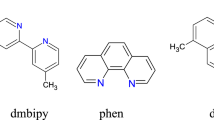Abstract
Titanocene and molybdenocene dichlorides belong to a new class of organometallic antitumor agent. Although these complexes are isostructural, they behave differently under physiological conditions and hence have different mechanisms of action. It was initially proposed that these species interact with DNA, inhibiting the cell cycle. Recent studies using nucleotides and oligonucleotides suggest that molybdenocene does not bind DNA constituents at physiological pH whereas titanocene apparently interacts weakly with nucleotides through the phosphoesters. The evidence for this was, however, obtained under non-physiological conditions. Herein we report an analytical method that enables determination of the amount of metal bound to DNA under physiological conditions (pH 7.4 and buffer solution) and with sample preparation (dialysis) that resembles the cell environment. It was found that more than 90% titanium was bound to DNA after 46 h whereas binding of molybdenum was no more than 5%.



Similar content being viewed by others
References
1 Köpf-Maier P (1994) Eur J Clin Pharmacol 47:1
2 Köpf-Maier P, Köpf H (1994) In: Fricker SP (ed) Metal compounds in cancer therapy; organometallic titanium, vanadium, niobium, molybdenum, and rhenium complexes—early transition metal antitumor drugs. Chapman and Hall, London, pp 109–146
3 Harding MM, Mokdsi G (2000) Curr Med Chem 7:1289
4 Meléndez E (2002) Crit Rev Oncol Hematol 42:309
5 Mokdsi G, Harding MM (2001) J Inorg Biochem 86:61
6 Guo M, Sun H, McArdle HJ, Sadler PJ (2000) Biochemistry 39:10023
7 Mokdsi G, Harding MM (1998) J Organomet Chem 565:29
8 Harding MM, Mokdsi G, Mackay JP, Prodigalidad M, Lucas SW (1998) Inorg Chem 37:2432
9 Köpf-Maier P, Martin R (1989) Virchows Arch B Cell Pathol 57:213
10 Guo M, Guo Z, Sadler PJ (2001) J Biol Inorg Chem 6:698
11 McLaughlin ML, Cronan JM Jr, Schaller TR, Snelling RD (1990) J Am Chem Soc 112:8949
12 Sanz-Medel A, Montes-Bayón M, Fernández Sánchez ML (2003) Anal Bioanal Chem 377:236
13 Heine DR, Denton MB, Schlabach TD (1982) Anal Chem 54:81
14 Toney JH, Marks TJ (1985) J Am Chem Soc 107:947
15 Döppert KJ (1987) J Organomet Chem 319:351
16 Meléndez E, Marrero M, Rivera C, Hernández E, Segal A (2000) Inorg Chim Acta 298:178
Acknowledgements
This research was supported by the National Institute of Health–SCORE Program.
Author information
Authors and Affiliations
Corresponding author
Rights and permissions
About this article
Cite this article
Vera, J.L., Román, F.R. & Meléndez, E. Study of titanocene–DNA and molybdenocene–DNA interactions by inductively coupled plasma–atomic emission spectroscopy. Anal Bioanal Chem 379, 399–403 (2004). https://doi.org/10.1007/s00216-004-2596-z
Received:
Revised:
Accepted:
Published:
Issue Date:
DOI: https://doi.org/10.1007/s00216-004-2596-z




